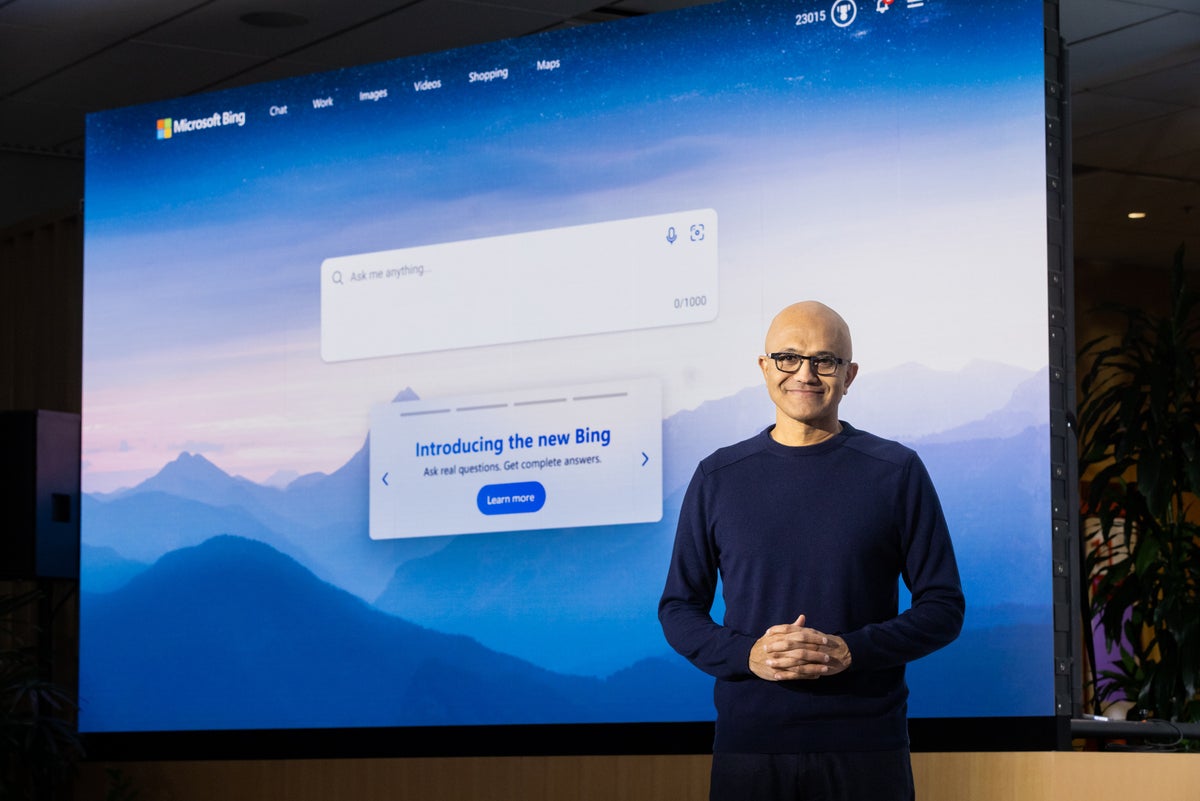Few companies have experienced the ups and downs of the nearly 50-year-old Microsoft. It helped launch the PC revolution in the 1970s and became a colossus of the tech world in the 1980s and 1990s, essentially setting the tech world’s agenda. Then after a federal anti-trust suit and CEO Steve Ballmer’s poor leadership, the company fell into a tailspin and lost its tech luster during a “lost decade” that began in 2000.
When Satya Nadella took over as CEO from Ballmer in 2014, Microsoft began a slow, steady ascent, betting on the cloud rather than relying on Windows. But its comeback wasn’t based on beating competitors with new, innovative technologies. Rather, Microsoft gained ground by leveraging already existing technologies including the cloud, Office and Windows. No one looked to it for exciting tech; no one expected it to set tech’s agenda.
And certainly no one looked to Microsoft for how we might live and work in the future — until ChatGPT chatbot and its integration with Bing took the world by storm. In a few short months, Microsoft morphed from a business that was about exciting as a utility company to one that is setting the tech agenda and has become the clear leader in artificial intelligence (AI).
Say good-bye, Cortana – you’re dumb as a rock
Although it seemed to happen at warp speed, the moment was years in the making. It started when Microsoft abandoned one of its most embarrassing big failures, Cortana, the digital assistant launched in 2014 to compete with Apple’s Siri and Amazon’s Alexa.
Cortana never got off the ground. In late 2018, I documented what an abject failure the digital assistant had become. I pointed out at the time that while Amazon had sold 50 million smart speakers running Alexa, sales of the one smart speaker with Cortana built into it were too small to measure.
I also noted something whose importance even I didn’t recognize at the time: Cortana was moved from the AI and Research Division into the Experiences & Users team. The Cortana team was gutted, with Microsoft’s Javier Soltero, the company’s vice president of Cortana, leaving by the end of the year. It seemed to me merely to signal that Microsoft knew Cortana had no future as a standalone assistant.
It didn’t. In 2020, Microsoft essentially killed it.
But the move involved a lot more than that. It represented Nadella’s recognition that the future of AI wasn’t in smart assistants like Cortana, Siri, and Alexa. Instead, he saw the future of AI — and possibly the future of computing — would be in generative AI like what is now ChatGPT. That’s why a little more than half a year after moving Cortana out of its AI division, Microsoft invested $1 billion in OpenAI, ChatGPT’s creator. Recently, it announced a follow-on $10 billion investment.
Nadella recently threw shade on Cortana and its entire cohort of digital assistants, saying they “Were all dumb as a rock. Whether it's Cortana or Alexa or Google Assistant or Siri, all these just don't work. We had a product that was supposed to be the new front-end to a lot of [information] that didn't work."
Why chatbots are the best digital assistants
Understanding the difference between how digital assistants and generative AI chatbots are developed (and how they work) goes a long way towards understanding why Nadella considers digital assistants the past — and ChatGPT the future.
You can find a deep dive into their differences in the New York Times. But here’s the quick version: digital assistants such as Siri, Alexa and Google Assistant are command-and-control systems. They can only understand and act on specific questions and requests, such as, “What movies are playing near me?” or “What will be the weather in Rome tomorrow?”
That makes them far more limited than chatbots like ChatGPT, which can perform an astonishing array of tasks from writing marketing copy to summarizing articles, creating graphics, writing code and much more. And even more is coming. At Microsoft’s “Future of Work” event, the company talked about the AI-powered Microsoft 365 Copilot, which can create Office documents on its own – for example, pulling together a PowerPoint presentation based entirely on a Word document, applying styles and animations throughout the presentation. Microsoft claims it can even draft a business proposal based only on meeting notes.
Not only are digital assistants drastically underpowered compared to chatbots, but coding them to do new tasks can be even harder. Former Apple engineer John Burkey, who worked on improving Siri, told the Times that even making a simple change such as adding new phrases to Siri’s data set can take up to six weeks because it requires rebuilding the whole underlying database. Adding a feature that’s more complex, such as a new search tool, can take almost a year.
Contrast that with the astonishing speed with which new capabilities are added to chatbots like ChatGPT on what sometimes seems like a daily basis. That’s because the chatbots are based on large language model technology.
And that’s why Microsoft is suddenly tech’s front-runner. Saying good-bye to Cortana and focusing on AI chatbots did the trick. That isn’t to say the race is over. Competitors, particularly Google, have for years been spending considerable resources on AI. Google has recently publicly launched its Bard chatbot. Others will follow.
Of course, AI may not prove to be as transformative as expected. It’s still early. Even the latest iteration, Chatbot GPT 4, is bedeviled by big problems. Like its predecessors, it’s prone to what researchers call “hallucinations” — what we in the real world call “bull*****ing” – making things up when it doesn’t know the answers.
But for the moment at least, Microsoft is in an unaccustomed spot — being the talk of the tech world, and in a good way.






